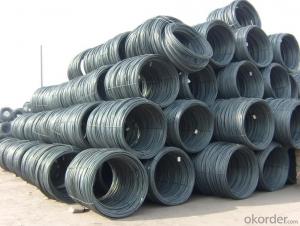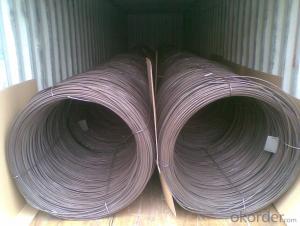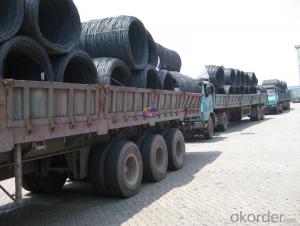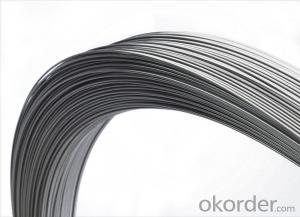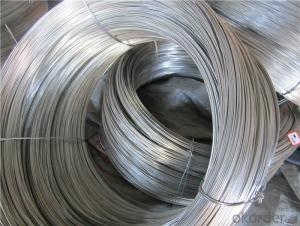SAE1006Cr Carbon Steel Wire Rod 17.5mm for Welding
- Loading Port:
- Shanghai
- Payment Terms:
- TT OR LC
- Min Order Qty:
- 100 m.t
- Supply Capability:
- 30000 m.t/month
OKorder Service Pledge
OKorder Financial Service
You Might Also Like
Item specifice
Description of SAE1006Cr Carbon Steel Wire Rod 17.5mm for Welding:
OKorder is offering Color Coated Steel Coil Prepainted Steel Coil at great prices with worldwide shipping. Our supplier is a world-class manufacturer of steel, with our products utilized the world over. OKorder annually supplies products to European, North American and Asian markets. We provide quotations within 24 hours of receiving an inquiry and guarantee competitive prices.
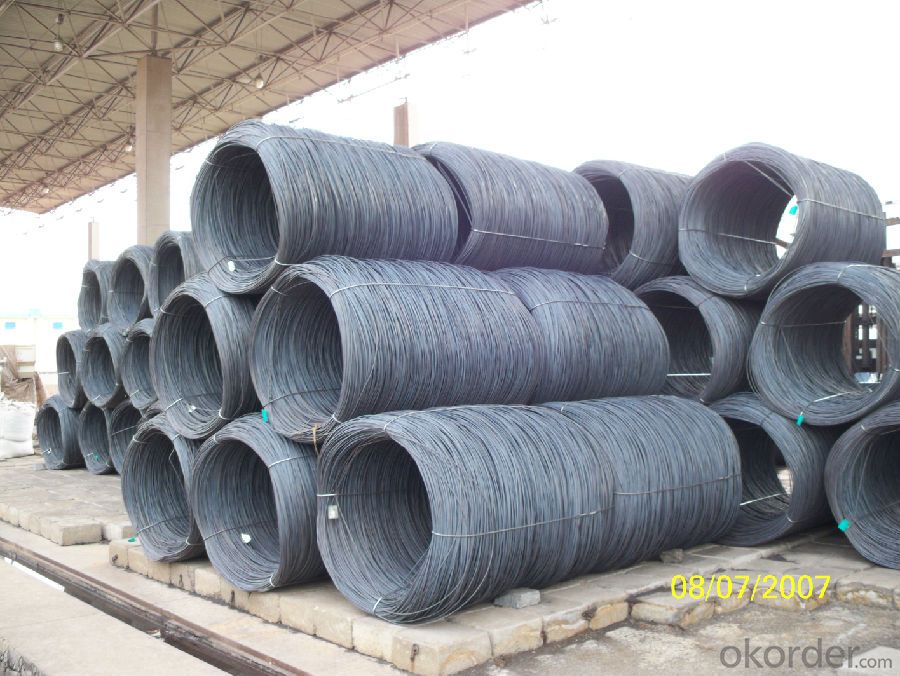
Applications of SAE1006Cr Carbon Steel Wire Rod 17.5mm for Welding:
Color Coated Steel Coil Prepainted Steel Coil are ideal for structural applications and are widely used in the construction of buildings and bridges, and the manufacturing, petrochemical, and transportation industries.
Main Product Features of SAE1006Cr Carbon Steel Wire Rod 17.5mm for Welding:
· Premium quality
· Prompt delivery & seaworthy packing (30 days after receiving deposit)
· Corrosion resistance
· Can be recycled and reused
· Mill test certification
· Professional Service
· Competitive pricing
Specifications of SAE1006Cr Carbon Steel Wire Rod 17.5mm for Welding:
1, Introduction: Color coated steel coils(sheets), i. E. PPGI, also called prepainted steel coils(sheets), are made of galvanized steel coils(sheets) with polymer coatings as surface. It's a new enclosure material and building board with characteristics of light-weighted, heat preserved&insulated, easily installed with bright colors.
2, Production Process: Pretreatment(Degreasing)_Drying_Chromating_Paint Basic Oil_Cooling_Drying_Color Coating_Cooling_Film-covering_Rolling Up
3, Characteristics:
Good at corrosion resistence. Besides zinc coating of the basic plate of galvanized steel sheet, the color coating as the surface has double lifetime to ensure better anticorrosion effect.
With excellent cold bending molded manufacturablity, PPGI products can be processed or directly used as final product. As being light-weighted and conveniently transported, they're widly used to replace wood to save energy.
4.There're thousands of colors can be chosen as per different application. Any color plays well in decoration.
No pollution with high recycling rate, PPGI coils and sheets are strongly recommended as enviroment-friendly products by the government.
5, eye bands and 4 circumferential bands in steel, galvanized metal fluted rings on inner and outer edges, galvanized.
| commodity | SAE1006Cr Carbon Steel Wire Rod 17.5mm for Welding |
| Techinical Standard: | JIS G3302-1998, EN10142/10137, ASTM A755 |
| grade | Q195,Q215,Q235,SAE1006,SAE1008 SAE1006Cr |
| Types: | Mesh welding |
| Base metal | galvanized, galvalume, cold rolled steel |
| Thickness | 0.14-1.0mm(0.16-0.8mm is the most advantage thickness) |
| Width | 610/724/820/914/1000/1200/1219/1220/1250mm |
| Type of coating: | PE, SMP, PVDF |
| Zinc coating | Z60-150g/m2 or AZ40-100g/m2 |
| Top painting: | 5 mic. Primer + 15 mc. R. M. P. |
| Back painting: | 5-7 mic. EP |
| Color: | According to RAL standard |
| ID coil | 508mm610mm |
| Coil weight: | 2--3MT |
| Package: | Properly packed for ocean freight exportation in 20'containers |
| Application: | Industrial panels, roofing and siding for painting/automobile |
| Price terms | FOB, CFR, CIF |
| Payment terms | 20%TT in advance+80% TT or irrevocable 80%L/C at sight |
| delivery time | 25 days after recepit of 20% TT |
| Remarks | Insurance is all risks |
| MTC 3.1 will be handed on with shipping documents | |
| We accept SGS certificatation test |
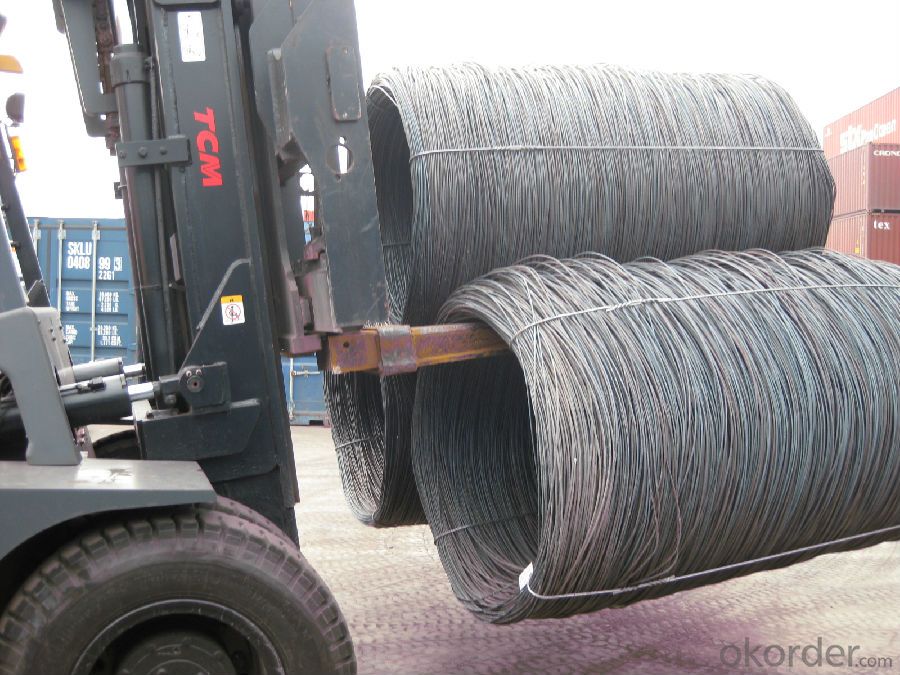
FAQ of SAE1006Cr Carbon Steel Wire Rod 17.5mm for Welding:
Q1: Why buy Materials & Equipment from OKorder.com?
A1: All products offered byOKorder.com are carefully selected from China's most reliable manufacturing enterprises. Through its ISO certifications, OKorder.com adheres to the highest standards and a commitment to supply chain safety and customer satisfaction.
Q2: How do we guarantee the quality of our products?
A2: We have established an advanced quality management system which conducts strict quality tests at every step, from raw materials to the final product. At the same time, we provide extensive follow-up service assurances as required.
Q3: How soon can we receive the product after purchase?
A3: Within three days of placing an order, we will begin production. The specific shipping date is dependent upon international and government factors, but is typically 7 to 10 workdays.
Q4: What makes stainless steel stainless?
A4: Stainless steel must contain at least 10.5 % chromium. It is this element that reacts with the oxygen in the air to form a complex chrome-oxide surface layer that is invisible but strong enough to prevent further oxygen from "staining" (rusting) the surface. Higher levels of chromium and the addition of other alloying elements such as nickel and molybdenum enhance this surface layer and improve the corrosion resistance of the stainless material.
Q5: Can stainless steel rust?
A5: Stainless does not "rust" as you think of regular steel rusting with a red oxide on the surface that flakes off. If you see red rust it is probably due to some iron particles that have contaminated the surface of the stainless steel and it is these iron particles that are rusting. Look at the source of the rusting and see if you can remove it from the surface.
- Q:How is steel wire rod coated for improved performance?
- Steel wire rod can be coated for improved performance through a variety of methods, including hot-dip galvanizing, electroplating, and powder coating. These processes provide a protective layer on the surface of the wire rod, enhancing its corrosion resistance, durability, and overall performance.
- Q:What are the major trends in the steel wire rod industry?
- The steel wire rod industry is currently being shaped by several significant trends. Firstly, there is a growing demand for steel wire rods across various industries such as construction, automotive, and manufacturing. This increased demand can be attributed to factors like population growth, urbanization, and global infrastructure development. Secondly, there are notable technological advancements taking place within the industry. These innovations aim to improve manufacturing processes, enhance wire rod quality, and reduce production costs. Automation, robotics, and data analytics are among the key technological trends that are revolutionizing the industry. Additionally, there is a shift towards more sustainable practices in the steel wire rod industry due to increasing environmental concerns. Companies are adopting energy-efficient technologies, reducing emissions, and implementing recycling programs to minimize their environmental impact. This trend is driven by both regulatory requirements and the industry's commitment to sustainability. Furthermore, the industry is experiencing market consolidation, as larger companies acquire smaller players and form strategic partnerships. This consolidation is driven by the need to optimize production capacities, expand global reach, and achieve economies of scale. Mergers and acquisitions are reshaping the competitive landscape of the industry. Lastly, steel wire rod manufacturers are increasingly focusing on product diversification to remain competitive. They are developing a wide range of wire rod products with varying specifications to cater to the diverse needs of different industries. Customization and flexibility in manufacturing are becoming crucial factors for success in the industry. Overall, these trends in the steel wire rod industry are driving it towards a more efficient, sustainable, and customer-centric future.
- Q:How is steel wire rod used in the manufacturing of wire fences?
- Steel wire rod is used as the primary material in the manufacturing of wire fences. It is first drawn through a series of dies to reduce its diameter and increase its strength, forming the wire. This wire is then woven or welded together to create the mesh structure of the fence. The strength and durability of steel wire rod make it an ideal choice for wire fences, providing security and longevity to the structure.
- Q:How is steel wire rod used in the manufacturing of wire rope anchors?
- Steel wire rod is used in the manufacturing of wire rope anchors as it serves as the primary material for producing the wire ropes themselves. The wire rod is typically formed into strands and twisted or braided together, creating a strong and durable wire rope that can be used for anchoring purposes.
- Q:How is steel wire rod used in the manufacturing of wire harnesses?
- Steel wire rod is used in the manufacturing of wire harnesses as it serves as the core material for the electrical conductors. The wire rod is first drawn through a series of dies to reduce its diameter and form a long, continuous wire. This wire is then twisted or braided with other wires to create the desired shape and structure of the wire harness. The steel wire rod provides the necessary strength and durability for the harness to withstand the electrical currents and mechanical stresses it may encounter during its use.
- Q:What are the different types of steel wire rod surface cleaning tools?
- There are several different types of steel wire rod surface cleaning tools available in the market. These tools are designed to remove dirt, rust, and other contaminants from the surface of steel wire rods, ensuring a clean and smooth finish. One common type of cleaning tool is a wire brush. These brushes have stiff bristles made from steel or other materials that are capable of removing rust and loose debris from the surface of the wire rod. Wire brushes are available in various shapes and sizes, allowing users to choose the one that best fits their needs. Another type of cleaning tool is a sanding disc or wheel. These tools are typically made from abrasive materials such as sandpaper or grinding wheels. They are mounted on a rotating machine, and when pressed against the surface of the wire rod, they remove rust and other contaminants through abrasion. Chemical cleaning agents are also used to clean steel wire rod surfaces. These agents are usually applied using a brush or spray, and they work by breaking down and dissolving the contaminants on the surface. After application, the surface is usually rinsed with water to remove the cleaning agent and any remaining residue. Ultrasonic cleaners are another option for cleaning steel wire rod surfaces. These machines use high-frequency sound waves to create tiny bubbles in a cleaning solution. As the bubbles implode, they create a scrubbing action that removes dirt, rust, and other contaminants from the surface of the wire rod. In addition to these tools, there are also specialized cleaning machines available for larger-scale operations. These machines often use a combination of mechanical, chemical, and/or ultrasonic cleaning methods to ensure a thorough and efficient cleaning process. Overall, the choice of cleaning tool will depend on the specific needs and requirements of the user. It is important to consider factors such as the extent of contamination, the desired finish, and the size of the wire rod when selecting the appropriate cleaning tool.
- Q:How is steel wire rod used in the manufacturing of wire meshes?
- The production of wire meshes heavily relies on steel wire rod, which is an indispensable component. This raw material boasts remarkable durability, strength, and flexibility, making it ideal for manufacturing wire mesh products. The manufacturing procedure commences with the utilization of carbon steel or stainless steel to create the steel wire rod. Initially, the steel wire rod is subjected to a series of machines that effectively reduce its diameter while simultaneously increasing its length. This process, known as drawing, serves to augment the wire's tensile strength. Subsequently, the drawn wire is meticulously cleaned and coated to enhance its resistance to corrosion. Once the wire is prepared, it is skillfully woven or welded to construct wire meshes. The creation of woven wire mesh entails interweaving individual wires in an over-under manner, thereby forming a mesh structure. This technique permits the implementation of diverse weaving patterns, including plain weave, twill weave, or Dutch weave, resulting in a wide array of mesh openings and wire diameters to fulfill various application requirements. On the other hand, welded wire mesh is fabricated by skillfully welding the intersecting points of the steel wire, yielding a more rigid and stable mesh structure. This type of wire mesh is commonly employed in situations necessitating high strength and stability, such as construction, fencing, and reinforcement applications. The applications of wire meshes span across numerous industries. They are frequently utilized in agriculture for animal enclosures, as well as in filtration and separation processes. Additionally, wire meshes serve as concrete reinforcement, find application in automotive manufacturing, and are even employed in the aerospace industry. Wire meshes offer exceptional strength, durability, and security, all while allowing for adequate airflow, visibility, and light transmission. In conclusion, steel wire rod occupies a pivotal role in the production of wire meshes. It undergoes an assortment of processes, including drawing, cleaning, and coating, to enhance its properties. Subsequently, the wire rod is woven or welded to generate wire meshes with distinctive patterns, opening sizes, and wire diameters. Wire meshes possess exceptional qualities, enabling them to cater to a wide array of industries due to their strength, versatility, and functional properties.
- Q:What are the common welding techniques used for steel wire rod?
- The common welding techniques used for steel wire rod include gas metal arc welding (GMAW), shielded metal arc welding (SMAW), and resistance welding.
- Q:How is steel wire rod used in the manufacturing of wire forms for elevator cables?
- The manufacturing process of wire forms for elevator cables heavily relies on steel wire rod. To meet the necessary strength and flexibility requirements, the steel wire rod is initially processed and drawn into a specific diameter and shape. Afterward, a protective layer is applied to the wire rod, enhancing its durability and resistance to corrosion. Once the steel wire rod is prepared, it undergoes further processing to form wire strands. These strands are then twisted together, resulting in elevator cables with the desired load-bearing capacity and strength. The specific requirements of the elevator cable determine the number of wire strands and the tightness of the twisting. The utilization of steel wire rod in wire form manufacturing guarantees that elevator cables can withstand the continuous movement and heavy loads involved in elevator operation. The safety and reliability of the elevator cables are greatly influenced by the strength and flexibility of the steel wire rod. Moreover, strict quality control measures are implemented in the manufacturing of elevator cables using steel wire rod to adhere to industry standards and regulations. This ensures that the wire forms produced using steel wire rod are of superior quality and capable of enduring the demanding demands of elevator systems. In conclusion, the role of steel wire rod in the manufacturing of wire forms for elevator cables is paramount. Its strength, flexibility, and durability are crucial in creating elevator cables that can safely and reliably transport passengers and goods within buildings.
- Q:What are the common industry opportunities for steel wire rod?
- Some common industry opportunities for steel wire rod include its use in construction for reinforcing concrete, manufacturing of wire products such as fencing, nails, and cables, as well as in automotive manufacturing for components like springs and suspension parts. Additionally, steel wire rod is also utilized in the production of electrical wires and in various industrial applications like welding electrodes and wire mesh.
1. Manufacturer Overview |
|
|---|---|
| Location | |
| Year Established | |
| Annual Output Value | |
| Main Markets | |
| Company Certifications | |
2. Manufacturer Certificates |
|
|---|---|
| a) Certification Name | |
| Range | |
| Reference | |
| Validity Period | |
3. Manufacturer Capability |
|
|---|---|
| a)Trade Capacity | |
| Nearest Port | |
| Export Percentage | |
| No.of Employees in Trade Department | |
| Language Spoken: | |
| b)Factory Information | |
| Factory Size: | |
| No. of Production Lines | |
| Contract Manufacturing | |
| Product Price Range | |
Send your message to us
SAE1006Cr Carbon Steel Wire Rod 17.5mm for Welding
- Loading Port:
- Shanghai
- Payment Terms:
- TT OR LC
- Min Order Qty:
- 100 m.t
- Supply Capability:
- 30000 m.t/month
OKorder Service Pledge
OKorder Financial Service
Similar products
New products
Hot products
Related keywords
